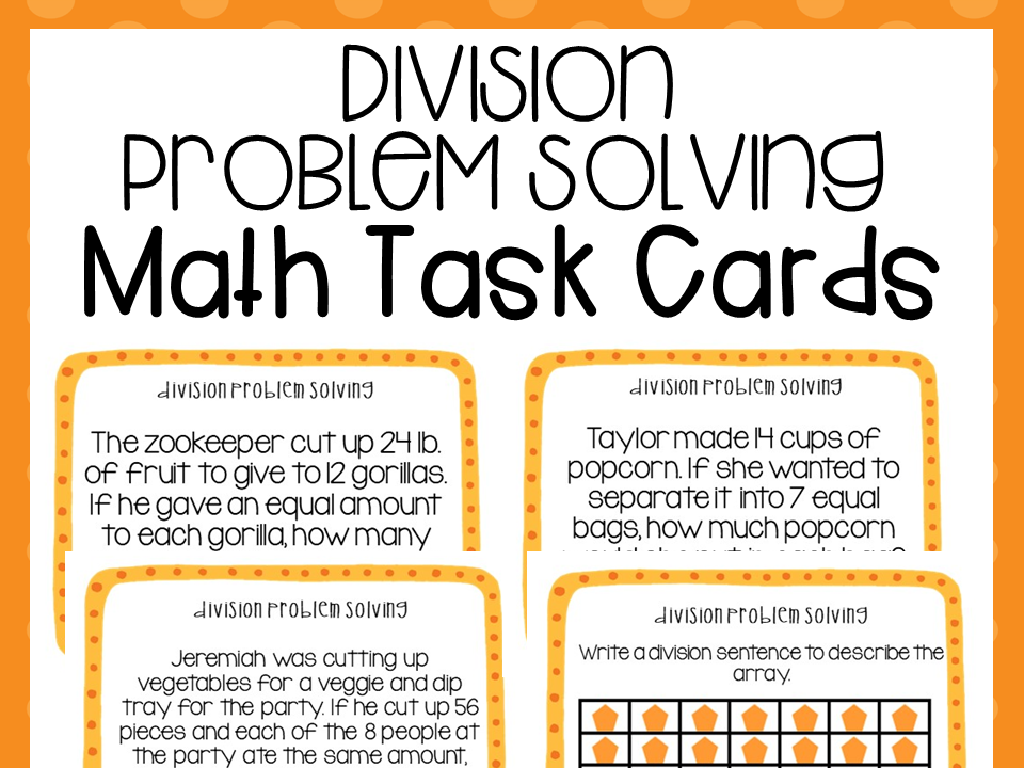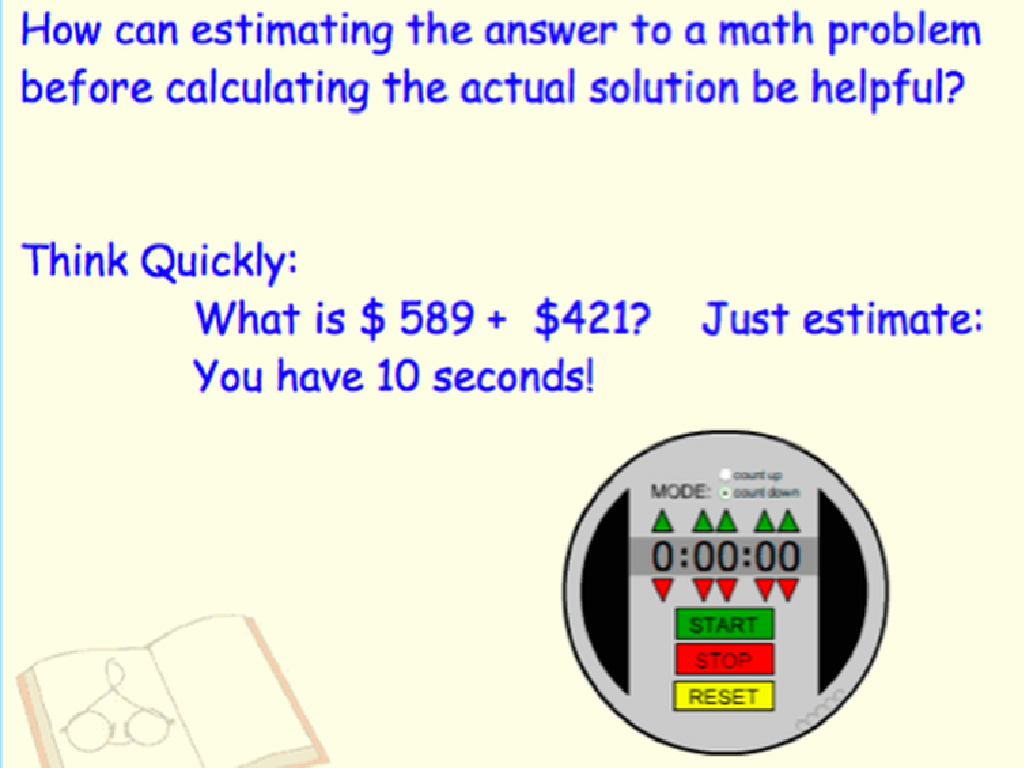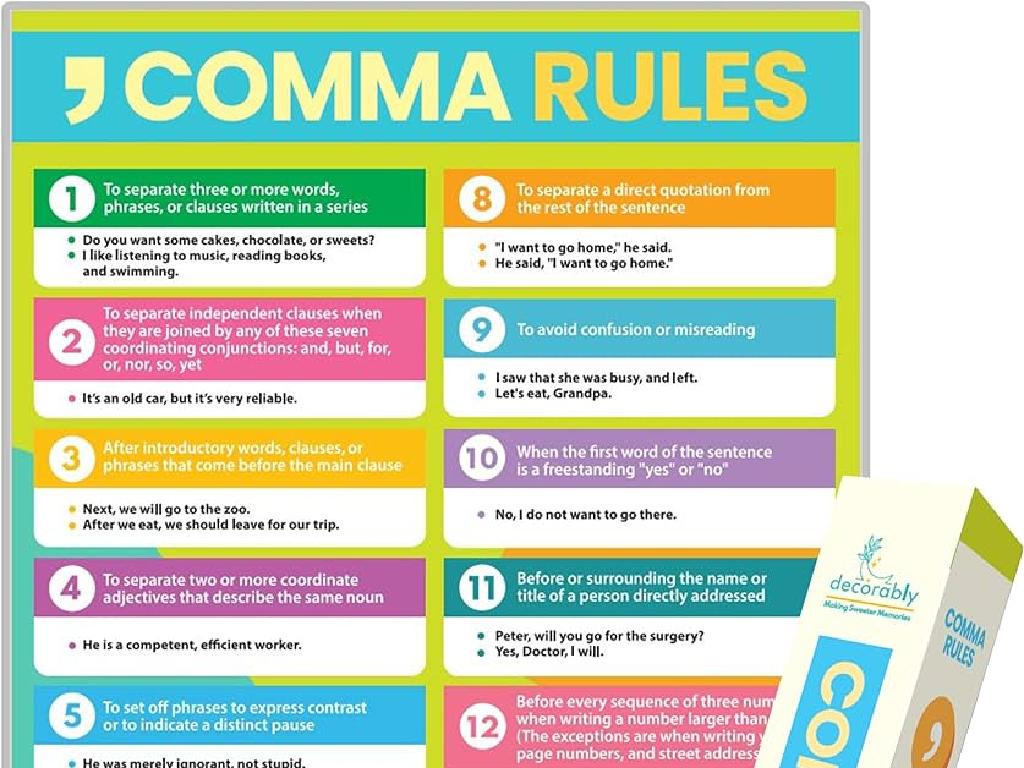Use The Pronoun That Agrees With The Antecedent
Subject: Language arts
Grade: Eighth grade
Topic: Pronouns And Antecedents
Please LOG IN to download the presentation. Access is available to registered users only.
View More Content
Pronouns and Antecedents: Ensuring Agreement
– Define pronouns and antecedents
– Pronouns replace nouns; antecedents are the nouns they refer to.
– Importance of correct pronoun use
– Using the correct pronoun avoids confusion and maintains clarity.
– Today’s goal: Pronoun-antecedent agreement
– Learn to match pronouns like ‘he’, ‘she’, ‘it’, ‘they’ with the nouns they replace.
– Practice with examples
– We’ll apply rules to ensure pronouns agree in number and gender with their antecedents.
|
This slide introduces the concept of pronouns and their antecedents, emphasizing the importance of using the correct pronoun to maintain clarity in writing. The goal for today’s lesson is to understand and apply the rules of pronoun-antecedent agreement. Students will learn that a pronoun must agree with its antecedent in number (singular or plural) and gender. Provide examples and practice sentences where students can identify the antecedents and select the appropriate pronouns. Encourage students to explain their choices to reinforce their understanding. This foundational skill will improve their writing coherence and precision.
Understanding Antecedents in Pronouns
– Define an antecedent
– An antecedent is the noun a pronoun replaces or refers to.
– Antecedent usage in sentences
– ‘Sara lost her book.’ – ‘her’ refers to ‘Sara’, the antecedent.
– Practice identifying antecedents
– Find the antecedent that ‘they’ refers to in a sentence.
|
This slide introduces the concept of antecedents and how they relate to pronouns. An antecedent is a word for which a pronoun stands and is usually a noun or noun phrase. When discussing examples, emphasize that the antecedent comes before the pronoun in the sentence and must agree in number and gender. In practice, students should identify the antecedent for given pronouns in sample sentences. This exercise will help them understand the importance of context and grammatical agreement in sentence construction. Encourage students to create their own sentences with clear antecedents for different pronouns.
Pronouns and Their Antecedents
– Review different types of pronouns
– Personal (he, she), possessive (his, hers), reflexive (himself, herself), etc.
– Understand pronoun-noun replacement
– Pronouns stand in for nouns to avoid repetition
– Exercise: Choosing the right pronoun
– Select pronouns that match the nouns they replace in sample sentences
– Ensuring pronoun-antecedent agreement
– Match pronouns correctly with the nouns they refer to
|
This slide aims to reinforce the understanding of pronouns and their correct usage in sentences. Begin with a review of the different types of pronouns, including personal, possessive, reflexive, and others, to ensure students can identify them. Explain how pronouns function as replacements for nouns, making sentences less repetitive and more coherent. Engage students with an exercise where they practice selecting the appropriate pronoun for a given sentence, focusing on ensuring that the pronoun agrees in number and gender with its antecedent. Emphasize the importance of this agreement to convey clear and accurate meaning in writing. Provide examples and encourage discussion to solidify the concept.
Pronoun-Antecedent Agreement: Number
– Singular vs. plural antecedents
– An antecedent is singular or plural, and pronouns must agree in number.
– Match singular antecedents and pronouns
– Use ‘he’ or ‘she’ for a singular antecedent like ‘the student’.
– Match plural antecedents and pronouns
– Use ‘they’ for a plural antecedent like ‘the students’.
– Practice: Correct mismatches
– Identify and fix errors where pronouns don’t match their antecedents.
|
This slide introduces the concept of pronoun-antecedent agreement in number, which is crucial for clear and grammatically correct writing. Start by explaining the difference between singular and plural antecedents. Emphasize that a singular pronoun refers to one person, place, thing, or idea, while a plural pronoun refers to more than one. Provide examples of correct and incorrect matches, and then engage the class with practice exercises where they correct sentences with pronoun-antecedent mismatches. This activity will help reinforce the rules and improve their editing skills for writing.
Agreement in Gender: Pronouns and Antecedents
– Understand masculine, feminine, neuter pronouns
– Masculine: he, him; Feminine: she, her; Neuter: it, they
– Match pronouns with antecedent gender
– Pronouns must reflect the gender of the noun they replace
– Activity: Correct gender pronoun usage
– Rewrite given sentences using appropriate gender pronouns
|
This slide introduces the concept of gender agreement between pronouns and their antecedents. Students should understand that pronouns are words used to replace nouns and must agree in gender (masculine, feminine, neuter) with the noun they are replacing. The class activity involves rewriting sentences to correct the pronoun usage based on gender. For example, if the sentence is ‘The teacher said that she would collect the homework,’ and the teacher is male, students should rewrite it as ‘The teacher said that he would collect the homework.’ Provide sentences with various gender contexts and encourage students to discuss why certain pronouns are appropriate. This exercise will help reinforce their understanding of pronoun-antecedent agreement.
Agreement in Person: Pronouns and Antecedents
– Understand pronoun persons
– Pronouns have ‘persons’: 1st (I, we), 2nd (you), 3rd (he, she, it, they)
– Match pronouns with antecedents
– Ensure pronouns agree with the person of their antecedents
– Group activity: Find person errors
– In groups, identify incorrect pronoun use in provided sentences
– Discuss importance of correct agreement
|
This slide introduces the concept of pronoun-antecedent agreement in person, which is crucial for clarity in writing. First, second, and third person pronouns must match the person of their antecedents. For example, ‘I’ (first person) should not be used to refer to an antecedent in the third person (‘the teacher’). The group work activity involves students working together to identify and correct errors in person agreement in sample sentences. This collaborative exercise will help reinforce the lesson and allow students to apply what they’ve learned. Provide clear examples and common mistakes to look out for. After the activity, discuss why using the correct pronoun person is important for clear communication.
Indefinite Pronouns and Agreement
– Define indefinite pronouns
– Words like ‘someone’, ‘anything’, ‘each’ are indefinite pronouns
– Agreement with antecedents
– They must agree in number with the antecedents they refer to
– Class exercise: Sentence completion
– Fill in blanks in sentences using correct indefinite pronouns
– Understanding pronoun usage
|
This slide introduces the concept of indefinite pronouns, which do not refer to a specific person, place, or thing. Emphasize the importance of agreement in number between the pronoun and its antecedent. For the class exercise, provide sentences with blanks for students to fill in with appropriate indefinite pronouns, ensuring they understand how to maintain agreement. This activity will help reinforce the lesson and give students practical experience with the material. Be prepared with examples and to clarify doubts. For instance, ‘Everyone is here, aren’t they?’ shows agreement even though ‘everyone’ feels singular, it pairs with the plural ‘they’.
Tricky Pronoun-Antecedent Agreement
– Collective nouns & pronoun use
– Use singular or plural pronouns based on the collective noun’s context
– Antecedents joined by ‘or/nor’
– Use a pronoun that agrees with the nearest antecedent
– Singular pronouns for ‘each’, ‘anyone’
– Words like ‘each’, ‘either’, ‘neither’, ‘anyone’, ‘nobody’ take singular pronouns
– Quiz on selecting correct pronouns
|
This slide addresses complex aspects of pronoun-antecedent agreement. Collective nouns can take either singular or plural pronouns depending on whether the group is acting as one unit or as individuals. When antecedents are connected by ‘or’ or ‘nor’, the pronoun should agree with the closest antecedent. Singular indefinite pronouns such as ‘each’, ‘either’, ‘neither’, ‘anyone’, and ‘nobody’ always take singular pronouns. The quiz at the end of the slide will help reinforce these rules by asking students to choose the correct pronoun in given sentences. For the quiz, prepare sentences that incorporate these tricky cases, and during the review, explain why each answer is correct to solidify understanding.
Let’s Practice Together: Pronoun-Antecedent Agreement
– Engage in an interactive activity
– Write sentences for peer review
– Create sentences using pronouns that agree with their antecedents.
– Exchange work with a partner
– Swap papers with a classmate to check for accuracy.
– Discuss correct pronoun usage
– Explain the rationale behind pronoun selection.
|
This slide introduces an interactive class activity focused on pronoun-antecedent agreement. Students will actively engage by writing sentences that demonstrate their understanding of how pronouns must agree with their antecedents in number, gender, and person. After writing, they will exchange their sentences with a partner for peer review, providing an opportunity for collaborative learning and correction of any mistakes. Following the exchange, there will be a class discussion where students share their sentences and explain why the pronouns they chose are correct, reinforcing the lesson through explanation and peer teaching. The teacher should facilitate the activity by providing guidance and ensuring that each student participates in both writing and reviewing. Possible activities for different students could include creating sentences based on personal experiences, sentences inspired by characters from a book they are reading, or sentences that involve common scenarios they encounter daily.
Class Activity: Pronoun-Antecedent Agreement Game
– Form teams for ‘Pronoun Match-Up’
– Match pronouns to antecedents on board
– Score points for correct matches
– Discuss pronoun-antecedent agreement
– Reflect on the rules that determine correct pronoun-antecedent matching
|
This interactive class activity is designed to reinforce the concept of pronoun-antecedent agreement. Divide the class into small teams and provide each team with a set of pronouns and sentences with missing pronouns. On the board, display sentences with antecedents that need matching pronouns. Each team will take turns choosing the correct pronoun for each antecedent. Points are awarded for correct matches, and the team with the most points at the end of the game wins. After the game, lead a discussion to reflect on the importance of matching pronouns correctly with their antecedents, emphasizing the rules that govern pronoun-antecedent agreement. This will help students understand how pronouns must agree in number, person, and gender with the antecedents they refer to. Possible variations of the game could include timed rounds, bonus challenge questions, or creating sentences from scratch that demonstrate proper agreement.






